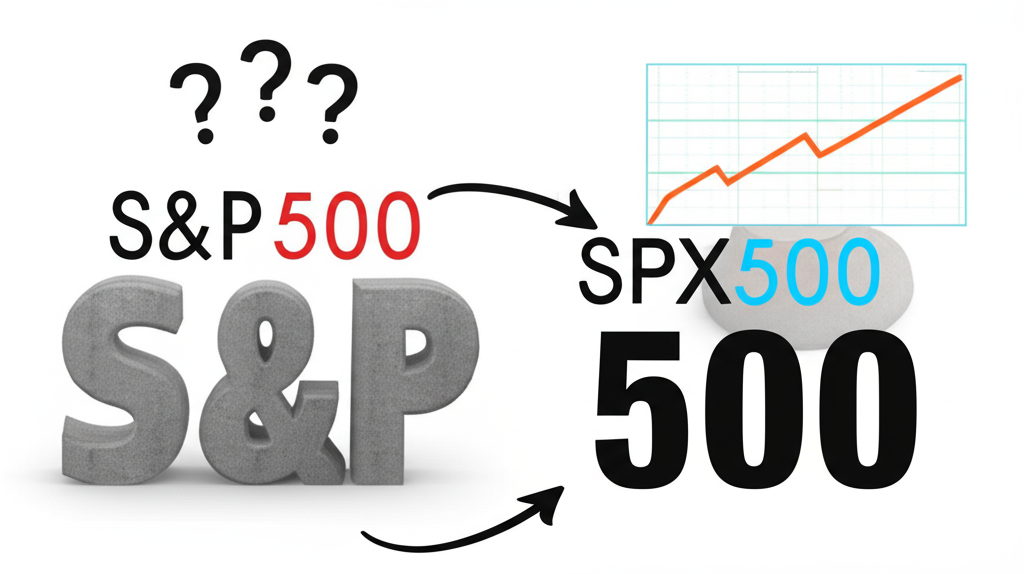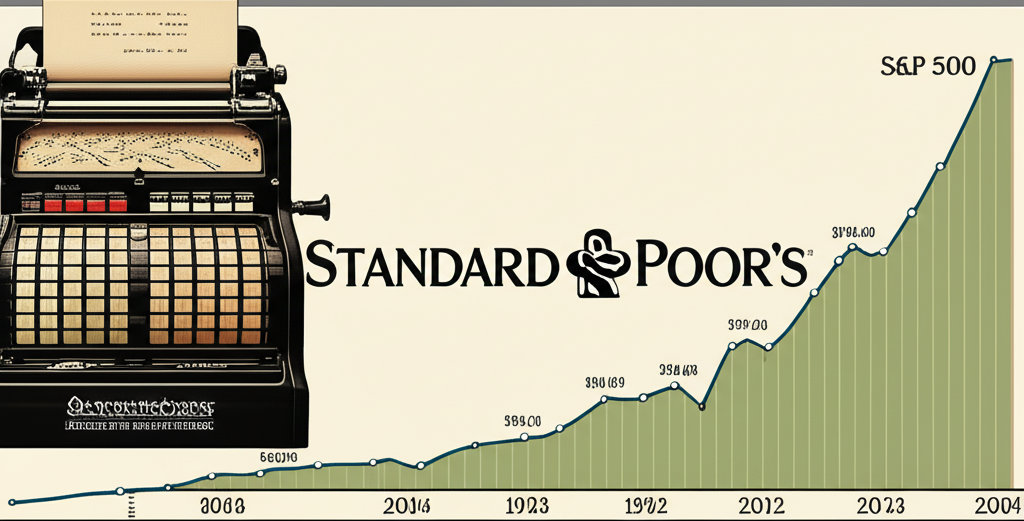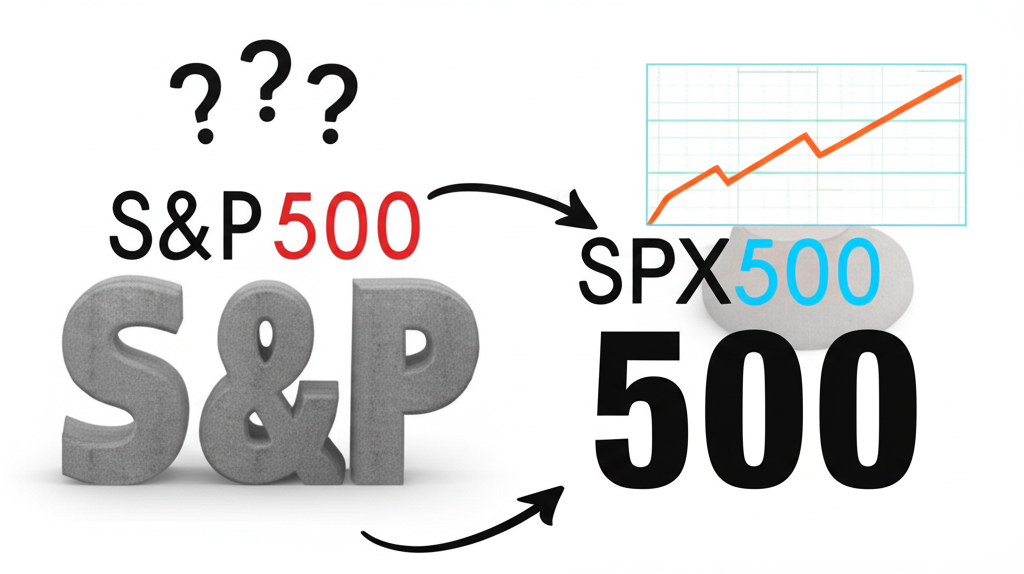Introduction: Decoding SPX500 and the S&P 500 Index

The S&P 500 stands as one of the most influential indicators of the U.S. financial landscape, often cited in news reports, economic analyses, and investment discussions. It reflects not just stock market trends but also broader economic confidence. Yet, many newcomers encounter confusion when they come across the term “SPX500.” At first glance, it seems interchangeable with the S&P 500—but is it really? The distinction matters, especially when deciding how to engage with this powerful market benchmark. This guide breaks down the essence of the S&P 500 Index, clarifies what SPX500 actually represents, and explores how both fit into investment and trading strategies. By the end, you’ll understand not only their differences but also how to make informed decisions based on your financial goals.
What is the S&P 500 Index? A Core Definition

The S&P 500 Index tracks the performance of 500 of the largest publicly traded companies in the United States. Maintained by S&P Dow Jones Indices, it’s widely regarded as the premier measure of large-cap U.S. equities. Unlike narrower indices that focus on specific sectors or smaller universes of stocks, the S&P 500 spans industries such as technology, healthcare, finance, consumer goods, and energy, offering a comprehensive snapshot of the American economy. Its broad reach means it accounts for roughly 80% of the total value of the U.S. equity market, making it a go-to reference for investors, fund managers, and economists. Whether you’re analyzing portfolio performance or assessing macroeconomic trends, the S&P 500 often serves as the benchmark against which success is measured.
The History and Evolution of Standard & Poor’s

The origins of the S&P 500 trace back to the early 20th century. In 1923, the Standard Statistics Company began publishing an index covering 233 U.S. firms, laying the groundwork for systematic market tracking. A pivotal moment came in 1941 when Standard Statistics merged with Poor’s Publishing—founded earlier by Henry Varnum Poor—to form Standard & Poor’s. This union brought together statistical analysis and financial publishing expertise, setting the stage for modern indexing. The official launch of the S&P 500 occurred on March 4, 1957, expanding its predecessor’s 90-company index to include 500 firms. This broader composition allowed for a more accurate reflection of the evolving U.S. economy. Over time, the methodology has been refined, but the core mission remains unchanged: to provide a reliable, transparent gauge of U.S. corporate health and market performance.
How the S&P 500 Works: Components and Calculation
Selecting companies for the S&P 500 isn’t purely an automated process based on size. Instead, a committee at S&P Dow Jones Indices evaluates potential constituents using a detailed set of criteria designed to ensure stability, liquidity, and representativeness. These include:
- Market Capitalization: Companies must have a minimum unadjusted market cap of around $14.6 billion, ensuring inclusion of only significant players in the market.
- Liquidity: Shares must be actively traded, allowing investors to enter and exit positions without causing sharp price swings.
- Public Float: At least half of a company’s shares must be available to public investors, excluding holdings by insiders, governments, or controlling shareholders.
- U.S. Domicile: The company must be headquartered in the United States, though it can generate revenue globally.
- Profitability: Firms must report positive earnings in the most recent quarter and over the past four quarters combined, ensuring financial viability.
- Sector Balance: The committee actively manages sector distribution to prevent overconcentration and maintain economic diversity across the index.
Rebalancing occurs quarterly, with periodic reviews allowing for additions or removals based on changing market conditions. This human-led oversight helps maintain the index’s integrity, avoiding mechanical flaws that purely formula-driven indices might face.
Understanding Market-Cap Weighting
One of the defining features of the S&P 500 is its market-capitalization-weighted structure. This means that larger companies have a proportionally greater influence on the index’s movements. For instance, a major shift in Apple’s stock price will impact the index far more than a similar percentage change in a smaller constituent like Kroger. The weighting is calculated using the “float-adjusted” market cap—total market value based only on shares available for public trading. This adjustment prevents distortions caused by closely held shares and ensures the index reflects what ordinary investors can realistically buy and sell. As a result, the top 10 holdings often account for a substantial portion of the index’s total value, particularly in recent years due to the dominance of tech giants.
S&P 500 vs. SPX500: Clarifying the Key Difference
Despite frequent use as if they were synonymous, the S&P 500 and SPX500 are not the same. The S&P 500 refers to the actual index—the theoretical basket of 500 stocks whose combined value is tracked daily. You see this number quoted in financial headlines: “The S&P 500 closed at 5,100.” It represents the real-time calculation of the market value of those companies.
In contrast, SPX500 is not an official ticker assigned by S&P Dow Jones Indices. Rather, it’s a label commonly used by online trading platforms and brokers to denote financial products linked to the S&P 500. Most often, SPX500 refers to:
- CFDs (Contracts for Difference): These allow traders to speculate on price changes without owning any underlying assets. Profits or losses depend on the difference between the opening and closing price of the contract.
- Futures Contracts: Particularly E-mini S&P 500 futures (official ticker: ES), which are standardized agreements to buy or sell the index at a future date. SPX500 is sometimes used informally to represent these instruments on retail trading interfaces.
So, while both relate to the same underlying benchmark, the S&P 500 is the foundation—the actual index—while SPX500 typically refers to tradable derivatives built upon it.
SPX500 as a Trading Instrument (CFDs and Futures)
When traders access SPX500 on a brokerage platform, they’re engaging with leveraged instruments tied to the S&P 500’s movement. These tools offer flexibility and speed, but come with heightened risks. Key characteristics include:
- Leverage: Traders can control large positions with a fraction of the capital—say, controlling $100,000 worth of exposure with just $5,000. While this magnifies gains, it also exposes them to outsized losses.
- Margin Requirements: Brokers require a deposit (margin) to open and maintain leveraged trades. If losses exceed available funds, a margin call may force position closure.
- Expiry Dates: Futures contracts have fixed expiration dates, requiring traders to either settle or roll over their positions. CFDs usually don’t expire but may incur overnight financing fees for holding long positions.
- Short-Selling Capability: Derivatives enable traders to profit from falling markets by opening short positions, a feature not always accessible or cost-effective in traditional investing.
These instruments attract active traders seeking to capitalize on short-term volatility, but they demand constant monitoring, strong discipline, and a clear risk management framework. They are fundamentally different from long-term index investing and should not be mistaken for a passive wealth-building strategy.
Why the S&P 500 Matters: Its Economic Significance
Beyond its role in portfolios, the S&P 500 functions as a vital pulse check on the U.S. economy. Because it includes leading companies across sectors—from Amazon and JPMorgan to UnitedHealth and Home Depot—its performance reflects broad economic trends. When the index rises steadily, it signals strong corporate earnings, consumer confidence, and favorable monetary conditions. A sustained decline, on the other hand, often precedes or accompanies recessions, tightening credit markets, or geopolitical turmoil. Policymakers, including those at the Federal Reserve, monitor the S&P 500 as part of their assessment of financial stability. For investors, it offers a real-time barometer of market sentiment. As highlighted on the S&P Dow Jones Indices website, the index is designed to be a leading indicator of U.S. equities, making it indispensable in both strategic planning and economic forecasting.
Historical Performance and Long-Term Trends
Over the long run, the S&P 500 has delivered impressive returns, reinforcing its status as a cornerstone of retirement and wealth accumulation strategies. While past performance doesn’t guarantee future results, historical data shows an average annual return of about 10% to 12%, including reinvested dividends. This return reflects the innovation, scalability, and resilience of American corporations over decades.
To illustrate its power, consider this: If you had invested $1,000 in the S&P 500 ten years ago and reinvested all dividends, your investment could now be worth over $2,500—assuming a simplified 10% annual growth rate. Of course, this journey wasn’t smooth. Markets experienced sharp drops during events like the 2020 pandemic crash or the 2022 rate-hiking cycle. Yet each time, the index eventually recovered and reached new highs. This pattern underscores a key principle: time in the market often trumps timing the market. For deeper insights into historical benchmarks and performance metrics, resources like Investopedia’s S&P 500 overview offer valuable context.
How to Engage with the S&P 500: Investing vs. Trading
There are two primary paths to gain exposure to the S&P 500: long-term investing and short-term trading. Each suits different objectives, timelines, and risk profiles. Choosing the right approach depends on your financial goals, experience, and tolerance for market swings.
Investing in the S&P 500 Index (Long-Term Strategy)
Long-term investing in the S&P 500 focuses on gradual wealth creation through compounding returns. This method suits individuals building retirement savings, education funds, or generational wealth. The most effective ways to participate include:
- S&P 500 Index Funds: Offered by firms like Vanguard and Fidelity, these mutual funds aim to replicate the index’s performance by holding all or a representative sample of its stocks. They typically charge low fees and are ideal for buy-and-hold investors.
- S&P 500 ETFs: Exchange-traded funds such as SPY, IVV, and VOO function like stocks and trade throughout the day. They offer even lower expense ratios and greater liquidity, making them popular among both novice and experienced investors.
This strategy benefits from diversification across hundreds of companies, reducing the impact of any single stock’s failure. It also minimizes emotional decision-making, as investors avoid reacting to daily market noise. Over decades, this disciplined approach has proven effective for building wealth, supported by the index’s historical upward trajectory.
Trading SPX500 Derivatives (Short-Term Strategy)
Trading SPX500-based derivatives is fundamentally different. Instead of owning assets, traders speculate on price movements using leveraged instruments. This approach answers the question of what SPX500 is used for in active markets. Common tools include:
- CFDs: Provided by many online brokers, CFDs let traders bet on whether the index will rise or fall, with profits or losses determined by price changes.
- Futures Contracts: Such as the E-mini S&P 500 (ES), widely used by institutions for hedging and by individuals for speculation. These contracts settle monthly and are traded on regulated exchanges like the CME.
- Options: These give the right—but not the obligation—to buy or sell the index or an ETF at a set price before expiration, offering strategic flexibility for advanced traders.
Due to leverage and rapid price movements, this path carries high risk. Success requires technical analysis skills, strict stop-loss rules, and emotional control. It’s not recommended for beginners or those with short investment horizons.
Factors Influencing the S&P 500’s Performance
The direction of the S&P 500 is shaped by a complex web of forces, ranging from economic data to global sentiment. Understanding these drivers helps investors anticipate shifts and manage expectations. Key influences include:
- Monetary Policy: Decisions by the Federal Reserve on interest rates and quantitative easing directly affect borrowing costs, corporate profits, and asset valuations. Rate hikes, for example, tend to pressure stock prices by increasing discount rates and slowing economic activity.
- Corporate Earnings: Since the index reflects company value, quarterly earnings reports play a critical role. Strong revenue growth and profit margins typically boost investor confidence, while misses can trigger sell-offs.
- Geopolitical Risks: Conflicts, trade tensions, elections, and pandemics introduce uncertainty, often leading to increased market volatility and risk-off behavior.
- Technological Innovation: Breakthroughs in AI, renewable energy, or biotech can propel entire sectors forward, benefiting index-heavy tech firms and reshaping long-term growth trajectories.
- Market Psychology: Investor sentiment, driven by news cycles, social media, and behavioral biases, can create momentum that temporarily decouples prices from fundamentals.
These factors interact dynamically, meaning the S&P 500 rarely moves due to a single cause. Instead, it reflects the collective assessment of millions of market participants weighing risks and opportunities.
Is it Safe to Invest in SPX500 (S&P 500)? Addressing Risks and Rewards
Safety depends heavily on how you engage with the index. The risks associated with long-term investing differ significantly from those in short-term trading.
For those investing in S&P 500 index funds or ETFs, the strategy is generally considered one of the safest ways to grow wealth over time. Diversification across 500 companies reduces company-specific risk, and the long-term trend of the U.S. economy supports gradual appreciation. However, it’s not risk-free:
- Market Volatility: The index can drop sharply during crises, such as the 2008 financial collapse or the 2020 pandemic sell-off.
- Economic Recessions: Broad downturns can depress earnings and valuations across multiple sectors simultaneously.
Despite these challenges, history shows that the index tends to recover and continue its upward path over five- to ten-year periods.
On the other hand, trading SPX500 derivatives introduces far greater danger:
- Leverage Risk: Small price moves can lead to large losses, sometimes exceeding the initial deposit.
- Time Sensitivity: Futures and options have expiration dates, adding pressure to predict not just direction but timing.
- Margin Calls: Adverse movements can trigger demands for additional funds, forcing liquidation at the worst possible moment.
- Complexity: These instruments require deep understanding of pricing models, spreads, and market mechanics.
Therefore, while long-term exposure to the S&P 500 aligns with conservative, goal-oriented investing, trading SPX500 derivatives belongs to the realm of high-risk speculation.
Conclusion: Your Path Forward with the S&P 500 and SPX500
The S&P 500 remains one of the most trusted reflections of U.S. economic strength and market performance. Its composition, methodology, and historical resilience make it a preferred choice for investors worldwide. Meanwhile, SPX500 represents a different facet—the world of derivative trading, where speed, leverage, and speculation dominate. Recognizing the difference between the two is essential. If you’re building wealth over decades, focus on low-cost index funds or ETFs. If you’re an experienced trader comfortable with volatility and risk, SPX500 products may offer tactical opportunities. Either way, clarity about your goals, time horizon, and risk appetite will guide smarter decisions. With this knowledge, you’re better equipped to navigate the financial markets with purpose and confidence.
Frequently Asked Questions About SPX500 and the S&P 500
1. Is SPX500 the exact same as the S&P 500 index?
No, they are not exactly the same. The S&P 500 is the underlying cash index, representing the aggregate value of 500 large U.S. companies. SPX500 is typically a ticker or product name used by brokers for derivative instruments, such as Contracts for Difference (CFDs) or futures contracts (like E-mini S&P 500 futures), that track the S&P 500’s performance.
2. What does SPX500 stand for, and what does it represent?
SPX500 does not stand for a specific acronym in the same way S&P 500 does. Instead, it’s a commonly used symbol or name by trading platforms to represent a derivative product that mirrors the price movements of the S&P 500 index, allowing traders to speculate on its value.
3. How can I invest in the S&P 500 index, and what are the main options?
You can invest in the S&P 500 index primarily through:
- S&P 500 Index Funds: Mutual funds that track the index.
- S&P 500 ETFs (Exchange Traded Funds): Funds that track the index and trade like stocks (e.g., SPY, IVV, VOO).
These methods offer broad diversification and are suitable for long-term growth.
4. Is it safe to invest or trade in SPX500, and what are the associated risks?
Long-term investing in S&P 500 index funds/ETFs is generally considered relatively safe due to diversification, though still subject to market volatility. Trading SPX500 derivatives (CFDs, futures) is significantly riskier due to the use of leverage, which can amplify both gains and losses, potentially exceeding your initial capital. It requires active management and a high-risk tolerance.
5. What if I had invested $1,000 in an S&P 500 index fund ten years ago?
While past performance is not a guarantee of future results, if we assume an average annual return of 10% (a historical average), an initial $1,000 investment would have grown to approximately $2,593.74 over ten years due to compounding. This illustrates the long-term wealth potential of index investing.
6. What are the primary factors that influence the SPX500’s price movements?
The SPX500’s price movements, mirroring the S&P 500, are influenced by:
- Macroeconomic factors (interest rates, inflation, GDP).
- Corporate earnings reports of constituent companies.
- Geopolitical events and global economic stability.
- Technological advancements and sector-specific trends.
- Overall investor sentiment and market psychology.
7. Why is the S&P 500 considered a key indicator of the U.S. economy?
The S&P 500 is considered a key indicator because it tracks 500 of the largest and most influential U.S. companies across diverse sectors, representing about 80% of the total U.S. stock market value. Its performance reflects the health of corporate America, investor confidence, and broader economic trends, making it a reliable barometer for the U.S. economy.
8. How are the 500 companies selected for inclusion in the S&P 500 index?
Companies are selected by a committee at S&P Dow Jones Indices based on criteria such as market capitalization, liquidity, public float, U.S. domicile, and profitability. The committee also considers sector representation to ensure the index remains diversified and accurately reflects the U.S. large-cap market.
9. What is the difference between investing in an S&P 500 ETF and trading SPX500 CFDs or futures?
The main differences lie in purpose and risk:
- S&P 500 ETF: Aims for long-term capital appreciation by owning a diversified portfolio of underlying stocks, typically with lower risk and fees.
- SPX500 CFDs/Futures: Short-term, speculative trading instruments that use leverage to profit from price movements without owning the underlying asset, carrying much higher risk.
10. Why is the index called “Standard and Poor’s”?
The index is called “Standard and Poor’s” because it originated from the merger of two companies in 1941: Standard Statistics Company and Poor’s Publishing. These two entities combined their expertise to create the Standard & Poor’s corporation, which later launched the modern S&P 500 Index in 1957.

留言